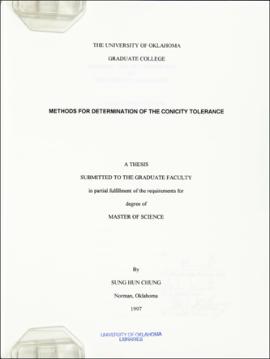| dc.contributor.author | Chung, Sung Hun | |
| dc.date.accessioned | 2020-11-13T18:00:13Z | |
| dc.date.available | 2020-11-13T18:00:13Z | |
| dc.date.created | 1997 | |
| dc.date.issued | 1997 | |
| dc.identifier.uri | https://hdl.handle.net/11244/326557 | |
| dc.description | Thesis (M.S.)--University of Oklahoma, 1997. | |
| dc.description | Includes bibliographical references (leaves 84-89). | |
| dc.description.abstract | This thesis attempts, for the first time, to develop comprehensive equations for determination of the conicity tolerance. No such attempts are evident in the current literature in conicity analysis. This thesis develops linear and nonlinear equations for the representation of a cone. For the minimum zone estimation of the conicity tolerance, linear and non-linear optimization methods are developed. Hence, the fundamental contribution of this work is in the mathematical development for cones. These methods are compared against the popular Least Squares Method (respectively linear and nonlinear formulation). Initial experiments are conducted and a preliminary analysis of results is presented. It was observed in these pilot studies that the Least Squares Method does not yield the minimum zone in the linear as well as the nonlinear cases. The form tolerance using the Minimum Zone Method is approximately 13% less than the form tolerance using the Least Squares Method. Further, the linear formulation may provide a good approximation and be used as an alternative to the general nonlinear formulation. | |
| dc.format.extent | xiii, 124 leaves | |
| dc.format.medium | xiii, 124 leaves : ill. ; 29 cm. | |
| dc.language.iso | eng | |
| dc.subject.lcsh | Cone | |
| dc.subject.lcsh | Linear programming | |
| dc.subject.lcsh | Nonlinear programming | |
| dc.subject.lcsh | Least squares | |
| dc.title | Methods for determination of the conicity tolerance | |
| dc.type | Text | |
| dc.contributor.committeeMember | Harvey, Craig, M. | |
| dc.contributor.committeeMember | Grant, Hank, F. | |
| dc.contributor.committeeMember | Raman, Shivakumar | |
